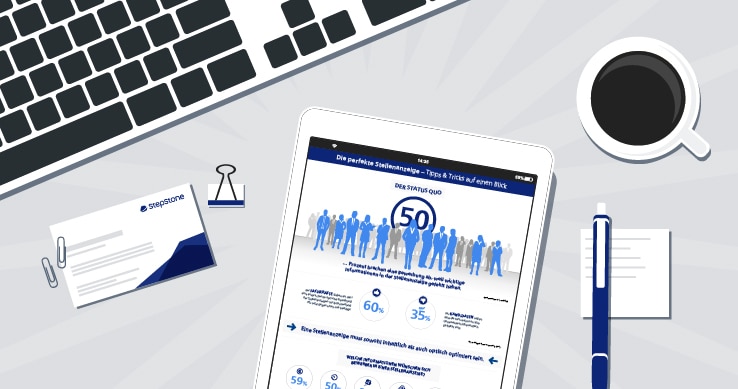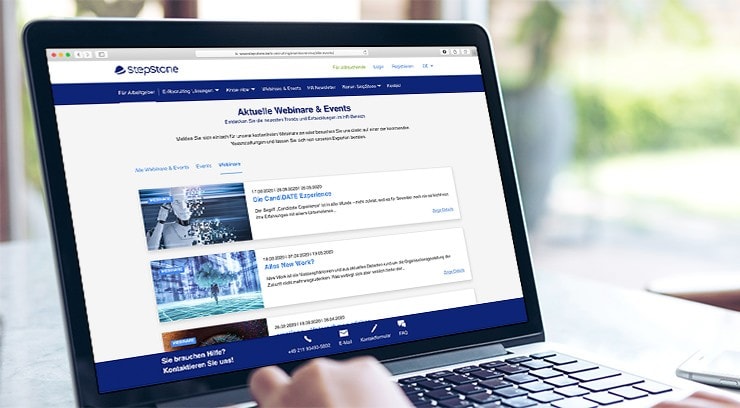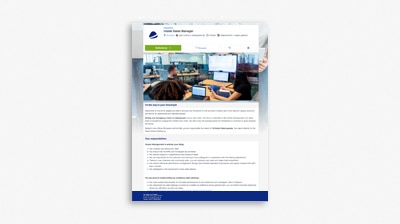The perfect job ad
Did you know that 50 per cent of candidates abandon applications because important information is missing from the job ad?

In a digital era, it’s no surprise that some two thirds of applicants use online platforms to look for a new job (source: Stepstone ‘Candidates in Focus’ study, 2017). Therefore, online job ads remain the number-one instrument when it comes to finding new and qualified employees.
An online job posting must meet a variety of requirements in terms of both content and appearance.
This guide provides a straightforward overview of how to create the perfect job ad.
Layout and structure of your job ad
The rules for all other web pages extend to online job ads: information presented clearly and consistently has a positive impact on the average time spent on/reading the page.
The more enjoyable it is for candidates to read the job ad, the more likely they are to apply.
The most important tips and tricks for clearly structuring a job ad
- Break your ad down into the following: job title, introduction/company profile, job description, requirements profile, benefits, contact details, additional information (e.g. location or call to action/application function).
- Split the individual sections into structured blocks.
- Highlight the titles of individual sections typographically.
- Visually emphasise the key information, especially the job title.
- Position the most important information towards the left, as people read from left to right.
- Use images to break up the ad.
Job title
The job title is what candidates see first. It is decisive in terms of drawing applicants to your advertisement. You should therefore make the job title as incisive as possible.
Avoid the following:
- A combination of different languages, e.g. German and English
- Job titles that are only used in your company’s internal jargon
- Fillers such as ‘We’re hiring/‘Career opportunity’
- Mentions of soft skills such as ‘team-oriented’ or ‘dedicated’
- Abbreviations such as “QA Manager”
Company profile
The introduction is designed to spark candidates’ interest and present the company. Alongside the size of the company and a description of its products and services, it is also advisable to outline the specifics of the sector in which your company operates.
Feel free to tell candidates more about the firm. Share with them your corporate vision, mission and values. Outline the vital contribution made by your company towards achieving an overarching goal and the role played by each individual employee. As such, candidates gain an initial insight into your corporate culture and get a sense of whether they can identify with it.
Stir the emotions and curiosity of applicants and avoid standard buzzwords such as ‘innovative’ and ‘leading’.
Other important considerations:
The company profile should be identical in all job ads, thus boosting your credibility among candidates.
Sample phrasing of a corporate mission:
‘As one of Germany’s largest digital companies, with more than 3,300 employees worldwide, we work hard every single day to find the “perfect match” between job hunters and companies.’
Be authentic!
Present your company as it really is and not how you would ideally like it to be. The latest surveys show that candidates can quickly spot empty phrases within job ads and often give little credence to common buzzwords.
Source: Stepstone ‘job search in spotlight’ study, 2018
Location
Is your company particularly well located? If so, mention it in your introduction.
False promises, exaggerations and smoke and mirrors? They will come to light sooner or later and will often lead to disappointment or, in the worst case, the premature departure of the new employee.
Location under the job title:
- It is preferable to have only one location per ad (if more than one location is preferable to place multiple ads)
- It is preferable to choose the name of the municipality (and not “Kempen” or “Province Brussels” or “Belgium”)
- No home office
- Avoid extras such as “Store – Hasselt”
Location on Google Maps:
- Always enter an existing Belgian postcode (without a postcode the job cannot be placed on the VDAB)
- Be as precise as possible and, if possible, give the full address
Job description
The main duties and responsibilities should be described unambiguously and in detail. According to a Stepstone survey, only 42 per cent of candidates feel that job descriptions outline duties and responsibilities in a way that gives a clear picture of the role.
Describe the role in as much detail as possible:
- Use keywords to describe the role in five to eight bullet points
- Establish a hierarchy of duties by starting with the most important ones and ending with more minor details
- Round off the section with information on strategic topics, the level of operational responsibility and/or current projects
Requirements profile
The required specialist knowledge and the desired qualifications (vocational or academic) must be clearly stated in the requirements profile.
- At the very least, you should describe the qualification(s) needed and the specialist knowledge relevant to the position
- Indicate how much professional experience you expect the ideal candidate to have
- If no qualifications or prior knowledge are required, make this clear
- Clearly state which requirements are essential and which are merely desirable
Once again, it is important to avoid the usual buzzwords such as ‘team-oriented’, ‘communicative’ and ‘able to work under pressure’. There are very few positions for which these skills are not required. Instead, you should try to define – as a team, if possible – which specific skills are genuinely important for the vacancy in question.
Always remember that applicants will be discouraged if the requirements are too high or too low. It’s all about striking the right balance.
Corporate benefits
Don’t just list what you expect from applicants. You should also explain what your company can offer them.
The Stepstone analysis ‘Job hunting in Focus’ shows that skilled workers are especially keen on the following corporate benefits:
- Financial benefits (e.g. occupational pension scheme, profit-sharing, performance-related bonuses)
- In-house canteen, free beverages, subsidised meals
- Sport and fitness programmes
- Employee events
- Childcare, family support department
Respondents were less interested in whether they receive a company smartphone or whether they can bring their pet to work.
Analyse the needs and priorities of the target group that you wish to reach with your job ad – and include benefits that are especially relevant to them.
Salary
Still rude to talk about money? As our Stepstone analysis shows:
Approx. 60% of job hunters want to see salary details in the job ad. Candidates would also like job ads to be more transparent on other matters too.
What information do applicants want to see in job ads?
Salary
Working hours and models
Training and professional development opportunities
The company as seen by employees
The culture of collaboration
Details of the role
Source: Stepstone ‘Success factors in recruiting’ study, 2017
Even though a variety of factors – e.g. the corporate culture and the location – do play a significant role in candidate decision-making, it has been shown that salary remains the number-one factor in terms of whether a position is accepted or rejected.
Competitive basic salary
Secure employment
Flexible working conditions
Professional training and development opportunities
Teamwork
Source: Stepstone ‘Success factors in recruiting’ study, 2017
In job advertisements, candidates often encounter vague terms such as ‘competitive salary’ or ‘performance-related remuneration’. Consequently, there is room for improvement in Germany when it comes to pay transparency.
While it is understandable that companies are reluctant to talk about salaries, a lack of transparency may give the impression that a firm wishes to leave open the possibility of hiring someone at the lowest possible rate.
So we should probably start talking more openly about money. When indicating the salary level in a job ad, it is important to research thoroughly what salary would be competitive for the position in question. Numerous factors play a role here: in which cities and federal states do employers offer the highest salaries? What are the best-paid industries?
Here, you will find important information about whether you are paying enough and what else you should bear in mind when setting pay levels.
More information

Company Profile
Show interested candidates who you are

Free webinars
Discover the latest trends and developments in HR thanks to our free webinars

Job ads
Fill vacancies quickly and easily
